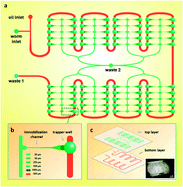A droplet-based microfluidic device integrated with a novel floatage-based trap array and a tapered immobilization channel array was presented for characterizing the neurotoxin-induced multiple responses in individual Caenorhabditis elegans (C. elegans) continuously. The established device enabled the evaluations of movement and fluorescence imaging analysis of individual C. elegans simultaneously. The utility of this device was demonstrated by the pharmacological evaluation of neurotoxin (6-hydroxydopamine, 6-OHDA) triggered mobility defects, neuron degeneration and oxidative stress in individual worms. Exposure of living worms to 6-OHDA could cause obvious mobility defects, selective degeneration of dopaminergic (DAergic) neurons, and increased oxidative stress in a dose dependent manner. These results are important towards the understanding of mechanisms leading to DAergic toxicity by neurotoxin and will be of benefit for the screening of new therapeutics for neurodegenerative diseases. This device was simple, stable and easy to operate, with the potential to facilitate whole-animal assays and drug screening in a high throughput manner at single animal resolution.

You have access to this article
 Please wait while we load your content...
Something went wrong. Try again?
Please wait while we load your content...
Something went wrong. Try again?


 Please wait while we load your content...
Please wait while we load your content...